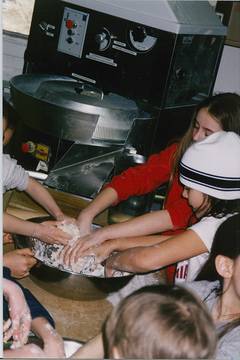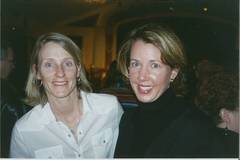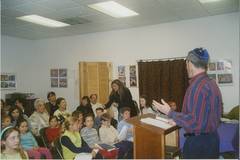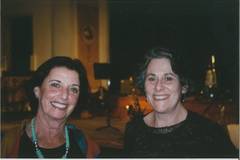Our History

Early religious school
A knock at the door
One day in 1993, there was a knock on Deborah Flateman’s door. She and her family had recently moved to Vermont and were living in a house off Maple Run Lane, up near Sterling Valley. Flateman opened the door, and in walked her new neighbor, Susan Federspiel, who welcomed her to town.
Flateman isn’t Jewish, but her husband was, and their social circle in Rhode Island had been largely Jewish. Flateman recalls that first neighborly visit: “She came in and we started talking about how we’re missing something here. She said, ‘I can tell you that there’s a small group of families in the area who get together periodically to do Shabbat dinners. It’s an informal kind of group.’”
Legend has it that it all began with a potluck at Betty Polow’s house in Morrisville in 1987, although there is some debate whether it was a Passover Seder or a Rosh Hashanah dinner. Polow thinks it was probably Rosh Hashanah. “I thought, ‘Let’s see if we can get a few people to come,’” Polow says. “I had a little article in the local paper and a couple people showed up. They all came to the potluck and that’s how we got started.”
It was haphazard for the first several years, with an event here or there. A Sukkot gathering in Federspiel’s backyard, a Tashlich service in the spot that would eventually become the Quiet Path. But Flateman and Federspiel wanted something more consistent, and along with newcomer Toni Barr, they decided to organize a meeting.
Area Jews weren’t easy to find. After all, it hadn’t been that long since Stowe was a restricted town with signs indicating that Jews and dogs were not allowed in the hotels. “Jews were not welcome in many instances,” Gretchen Besser explains. “My uncle used to come here to ski, before there was a lift. Climb the mountain; one run a day. And there was no place he could stay except some farm house.”
Area hotels had explicit rules limiting access for Jews well into the 1950s. Even when those practices ended, many Jews flew below the radar, avoiding drawing attention to themselves.
Barr says that discretion hadn’t changed in 1993. “We had that first meeting and I remembered people saying, ‘You’re Jewish?! I just played cards with you.’ Because being Jewish here was a big secret.”

An early fundraiser, with a very young Sarah McLachlan singing.
Getting organized
That initial meeting catalyzed Jews in the area. Interest in a religious school combined with the momentum of Betty Polow’s potluck group to get the ball rolling. By fall of 1993, there were 13 Jewish children meeting twice a month with a teacher. The following year, the group decided to organize into a formal nonprofit with bylaws and membership.
"There was a community trying to form,” says Sara Schlosser, whose parents, Ted and Barbara Kole, were active among the founders. “We didn’t even email then. I’m trying to think how we got the word out.” Some families were brought in by word of mouth, and others saw an article Federspiel got into the paper. Somehow they showed up; the community grew.
Everything was uncertain but blooming with potential. Flateman recalls Marvin Gameroff –– a Montreal part-time resident and owner of the Green Mountain Inn –– telling her: “This is never going to work. Everybody stays quiet. Jews are quiet in Stowe.” She replied: “They don’t have a place to convene and raise a voice. Marvin, sometime you’re going to give us enough money to build a building.”
As the group formalized, they debated possible names. It felt important to honor that this was bigger than one location and more than just a particular branch of Judaism. They wanted a word that connoted inclusivity for secular and religious Jews. They settled on the word greater.
"That was the foundation of JCOGS. Everyone’s included,” Barr says. “We should always remain inclusive.”
Establishing a religious school was paramount for founders such as Irwin Belitsky and Nancy Krakower. Young parents wanted a way to raise their children with a connection to Judaism. In 1995, the newly named Jewish Community of Greater Stowe formalized the religious school and began to meet at Stowe Cooperative Nursery. Early teachers included Emily DeGiulio, Marlene Maron, and Jude Elford.
Krakower explains that the religious school grew up with the children. “We became the children’s education committee: me and my peers. We wanted more exposure for our kids so we grew the programming. It went from once a month to twice a week. We made changes as they got older and as their needs changed.”
Membership grew, too. The first membership drive in 1996 drew 174 families and individuals. Some members were second homeowners, but most were Jews living in the area who were eager to build Jewish community.
Al and Gretchen Besser knew that the center of any Jewish community is the Torah, and they wanted JCOGS to have a scroll. “Zal Stern located a special Torah –– a Holocaust survivor from Lithuania –– which we bought for JCOGS,” Gretchen says. "Although it's heavy, physically, the script is large and beautiful."
On August 14, 1999, a ceremony was held to welcome the Torah into the community, led by Al and Gretchen’s son, Brian. “United in song, as we passed the Torah from one person to the next, the 90-plus congregant voices filled the conference room of the Green Mountain Inn,” says Patti Rubin.
Rita Schneps also remembers passing the Torah. “They married the congregation to the Torah under a chuppah made of a prayer shawl and ski poles. It was very emotional.”
Deborah Flatemen’s friend, Steve Berson, recalls, “They made their presentation and handed the Torah over to Deborah and Deborah has a tricky back. She winced and we made eye contact and her eyes just said ‘Get up here now.’ And so I went up and took it and paraded it around and it was a harbinger of things to come.”

Purim
An itinerant congregation
JCOGS had a Torah. It had a spiritual center. What it did not have was a physical center; it functioned as an itinerant congregation with a few Seders up at Topnotch and services over at the Green Mountain Inn.
Then there were the holidays at Barbara and Zal Stern’s house. “They brought the Torah that the Bessers bought, and everybody davened,” part-time resident Mitzi Becker. “Hillel did part of the service, Zal did part of the service. Everybody read. It was very much a do it yourself event.”
"And you had this view across to Mt. Washington almost,” adds her husband, Hillel. “Sukkot you had fall colors. Shavuot you had new greenery. There was such a spirit there. With the food afterwards because Barbara always served a nice kiddush.”
From 1999-2004, JCOGS rented a space in the Baggy Knees shopping center where the congregation could gather and worship. Rubin organized services, which were lay-led. Hillel Becker –– the son of a Montreal rabbi who founded three synagogues –– was often called upon to lead services.
It wasn’t always easy to get a minyan, but fortunately there was a Chinese restaurant nearby. If they were short a couple of people, says Rubin, “Someone would go to the Chinese restaurant and say, ‘We need Jews!’” It usually worked.
For High Holy Day services at the Commodore’s Inn, a rabbi was brought in and Bernie Nisenholtz blew the shofar. Berson points out that the High Holy Days always fall during foliage season. In 1998, “We left the conference room at the Commodore’s and we went into the lobby and there were buses and people and some of us still had yarmulkes and tallit. I felt uncomfortable and I know other people did.” He began to wonder, “Why do we keep wandering around? At what point are we going to decide that we are a permanent part of the community and have our own place?”
There was hesitation about constructing a building, however. Part of that was natural resistance to change. But also, says Berson, “They were afraid knowing the history of Stowe and the anti-Semitism in Stowe; they wanted us to keep our heads down and not be too visible.”
The final straw occurred during Hebrew school, which took place in the basement of the Stowe Community Church. One day, there was a coffin laid out in the basement, and the students figured out there was a dead body inside. They decided they just wanted to go home. After that incident, Berson says, the young parents got behind the idea of a permanent building.
Marvin Gameroff, however, wasn’t convinced. What the community really needed, he felt, was a cemetery. He approached the Stowe cemetery commission and asked for 30 or 40 plots to be set aside for JCOGS members. When they refused, Gameroff was upset and convinced the decision was the result of anti-Semitism.
Berson went to his friend and said, “Let’s put this on the back burner.” Gameroff’s reply, according to Berson was: “You’re going to need help, and I’m going to help you. You promise me that once the building is done you’ll make the cemetery the next priority.”
"And I shook his hand and said, ‘Marvin, I promise once the building is up, JCOGS will have its own cemetery.’” At that, Gameroff donated the land, fulfilling Flateman’s prediction. Now all that was needed was money. And a plan.

Breaking ground
Building a building
Berson became president in 1999 and the building campaign began in earnest in 2000, with Berson, Krakower, and Gameroff at the helm. Also central was Roselle Abramowitz, a childhood Holocaust survivor from Montreal who had recently retired to Stowe. “She and others realized they needed a place,” recalls her daughter, Marcie Scudder. “Someplace to ground them, someplace to connect them.”
Planning was a community process, with all the committee chairs weighing in on a spatial needs assessment. There were site-specific needs, of course, and the consensus was that the space should be flexible, with the potential to open and close a partition. The building would need to be expandable, built with the potential to push out if the congregation grew. The question of a Kosher kitchen raised some hackles, with Zal Stern supporting it and other families wondering why we would need such an expensive facility.
And then there was the issue of appearances. “We wanted something that would have some height to it,” says Berson. “Marvin was keen on Greek Revival. Zal Stern took me on a tour of all the Montreal synagogues. He knew I was a High Holiday Jew, and he wanted to educate me.”
In the midst of all this planning, Al and Gretchen’s son Brian moved to Vermont. People were beginning to think it was time for a spiritual leader, so Brian’s arrival seemed fortuitous. In January 2001, he came on part time as the first spiritual leader to the congregation. He would end up delivering his first Rosh Hashanah sermon right after the Twin Towers fell.
"He empowered others in creating a spiritual culture. His respect for all, coupled with his strength of character defined him as a spiritual leader,” says Rubin.
With a Torah and a spiritual leader and a building on the way, JCOGS was growing and changing. Religious leaders from the area came to the groundbreaking, with board members cutting into the earth.
Then, in 2004, Marvin Gameroff died. Gameroff had been central to JCOGS, not only donating the land and our second Torah, but also inspiring everyone with his commitment to community.
Berson remembers: “Marvin didn’t live to see the building done. The building was framed up and had a roof and windows and doors, but inside was bare studs. We got a temporary certificate of occupancy. Nancy and I decided we wanted Marvin’s memorial service to be the first official event in the building. There was no electricity, it was all done by candles. It was great, really, to honor Marvin and all that he did.”
The truest way for JCOGS to honor Gameroff was to fulfill Berson’s promise to build a cemetery. Abramowitz, too, was invested in the need for a cemetery, says Scudder: “Her parents had no marked graves, so it was very important to her that every person should have a marked grave.”
The North Country Animal League had recently been given a plot of land they weren’t going to use, and they wanted neighbors who wouldn’t disturb the animals. They sold the land to JCOGS, writing into the deed that there should always be a dog path around the cemetery. And so, Darchei Shalom Cemetery was created.
"Synagogues come and go, but cemeteries are forever,” says Berson.
On Friday, January 21, 2005, after four years of active planning, JCOGS held its first Shabbat service in the new building. “We had close to 100 for that Shehecheyanu moment in JCOGS' history,” explains Rubin. “We were finally in our sacred space. Eyes sparkled from tears of joy. Smiles were wide with pride. Given that every member contributed, the bonds were evident: we would move forward as one strong congregation.”

Matzah-making at Pie in the Sky
L’dor vador –– from generation to generation
Federspiel and Flateman moved out of state. Abramowitz passed away, with Susan Fishman picking up the mantle of caring for the design of the building. Brian Besser became ordained and served the congregation as our part-time rabbi, staying at JCOGS for twelve years before moving away.
Zal Stern had trained Bernie Nisenholtz to blow the shofar, and Nisenholtz trained Steve Schneps, who has been blowing the shofar at JCOGS for over a decade. Then Nisenholtz passed away. “I try to make it so Bernie can hear it too,” says Steve, who is now training a young shofar blower in the congregation. “It’s a passing on of the tradition l’dor vador.”
To Federspiel, this is all as it should be. “It’s like all of Jewish history, people do what they do and then they pass it on to the next people."
In 2014, JCOGS hired David Fainsilber as our first full-time rabbi. Barr points out that this, too, is l’dor vador. “Our roots are inclusive. Having the rabbi has lived the greater. That’s what JCOGS is now; that’s what it’s always been.”
"David married my daughter and buried my mother within two weeks and got ordained in the middle of it,” says Scudder. “He did my grandson’s mikveh. He’s been the only rabbi who has connected the generations for me.”
What’s the consistent thing? The magic of JCOGS? It’s the greater, and it’s also the community that comes from working to build something together.
In the early days, “If we didn’t do these things, our children wouldn’t have the exposure. If we didn’t do the committee, if we didn’t plan the events, they weren’t there,” Krakower says. “Whatever you wanted, you had to do it. That definitely was an enriching way to experience Jewish life.”
That, too, has never changed. The JCOGS of today is as founded on volunteerism as it was 26 years ago, when Susan Federspiel knocked on Deborah Flateman’s new front door. “Something so innocent –– we need to bring our people together,” muses Flateman, “turned into something as impressive as it is today. I just can’t tell you how that makes me feel.”



Tue, December 2 2025
12 Kislev 5786
Today's Calendar
: 11:30am |
Friday Night
Shabbat Day
: 10:00am |
: 10:00am |
Upcoming Programs & Events
Dec 2 |
Dec 3 |
Dec 3 |
Dec 4 |
Dec 5 |
Erev Hanukkah
| Sunday, Dec 14 |
Join Our Mailing List
Zmanim
| Alot Hashachar | 5:35am |
| Earliest Tallit | 6:10am |
| Netz (Sunrise) | 7:08am |
| Latest Shema | 9:23am |
| Zman Tefillah | 10:09am |
| Chatzot (Midday) | 11:40am |
| Mincha Gedola | 12:03pm |
| Mincha Ketana | 2:19pm |
| Plag HaMincha | 3:16pm |
| Shkiah (Sunset) | 4:12pm |
| Tzeit Hakochavim | 5:00pm |
| More >> | |
Shabbat services normally begin every Friday at 6pm throughout the year.
Check the calendar for what’s coming up or sign up for our weekly emails here.
Privacy Settings | Privacy Policy | Member Terms
©2025 All rights reserved. Find out more about ShulCloud
